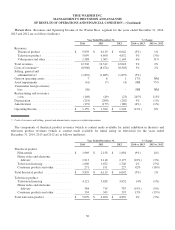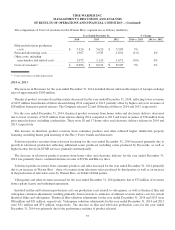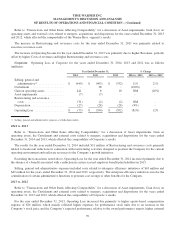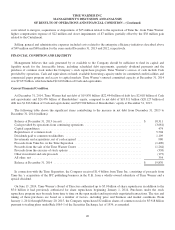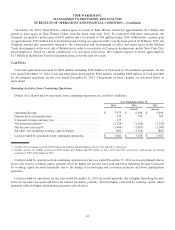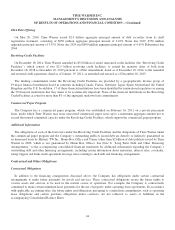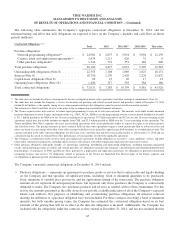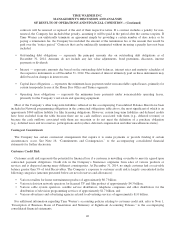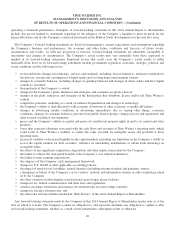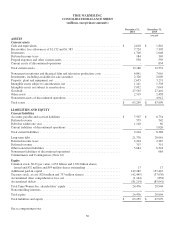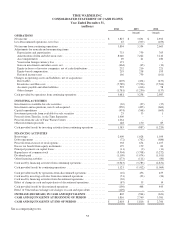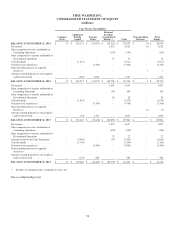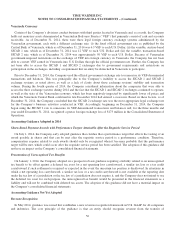Time Magazine 2014 Annual Report Download - page 62
Download and view the complete annual report
Please find page 62 of the 2014 Time Magazine annual report below. You can navigate through the pages in the report by either clicking on the pages listed below, or by using the keyword search tool below to find specific information within the annual report.TIME WARNER INC.
MANAGEMENT’S DISCUSSION AND ANALYSIS
OF RESULTS OF OPERATIONS AND FINANCIAL CONDITION – (Continued)
contracts will be renewed or replaced at the end of their respective terms. If a contract includes a penalty for non-
renewal, the Company has included that penalty, assuming it will be paid in the period after the contract expires. If
Time Warner can unilaterally terminate an agreement simply by providing a certain number of days notice or by
paying a termination fee, the Company has included the amount of the termination fee or the amount that would be
paid over the “notice period.” Contracts that can be unilaterally terminated without incurring a penalty have not been
included.
• Outstanding debt obligations — represents the principal amounts due on outstanding debt obligations as of
December 31, 2014. Amounts do not include any fair value adjustments, bond premiums, discounts, interest
payments or dividends.
• Interest — represents amounts due based on the outstanding debt balances, interest rates and maturity schedules of
the respective instruments as of December 31, 2014. The amount of interest ultimately paid on these instruments may
differ based on changes in interest rates.
• Capital lease obligations — represents the minimum lease payments under noncancelable capital leases, primarily for
certain transponder leases at the Home Box Office and Turner segments.
• Operating lease obligations — represents the minimum lease payments under noncancelable operating leases,
primarily for the Company’s real estate and operating equipment.
Most of the Company’s other long-term liabilities reflected in the accompanying Consolidated Balance Sheet have been
included in Network programming obligations in the contractual obligations table above, the most significant of which is an
approximate $960 million liability for film licensing obligations. However, certain long-term liabilities and deferred credits
have been excluded from the table because there are no cash outflows associated with them (e.g., deferred revenue) or
because the cash outflows associated with them are uncertain or do not meet the definition of a purchase obligation
(e.g., deferred taxes and tax reserves, participations and royalties, deferred compensation and other miscellaneous items).
Contingent Commitments
The Company has certain contractual arrangements that require it to make payments or provide funding if certain
circumstances occur. See Note 16, “Commitments and Contingencies,” to the accompanying consolidated financial
statements for further discussion.
Customer Credit Risk
Customer credit risk represents the potential for financial loss if a customer is unwilling or unable to meet its agreed upon
contractual payment obligations. Credit risk in the Company’s businesses originates from sales of various products or
services and is dispersed among many different counterparties. At December 31, 2014, no single customer had a receivable
balance greater than 5% of total Receivables. The Company’s exposure to customer credit risk is largely concentrated in the
following categories (amounts presented below are net of reserves and allowances):
• Various retailers for home entertainment product of approximately $0.7 billion;
• Various television network operators for licensed TV and film product of approximately $4.3 billion;
• Various cable system operators, satellite service distributors, telephone companies and other distributors for the
distribution of television programming services of approximately $1.7 billion; and
• Various advertisers and advertising agencies related to advertising services of approximately $1.0 billion.
For additional information regarding Time Warner’s accounting policies relating to customer credit risk, refer to Note 1,
“Description of Business, Basis of Presentation and Summary of Significant Accounting Policies,” to the accompanying
consolidated financial statements.
46


